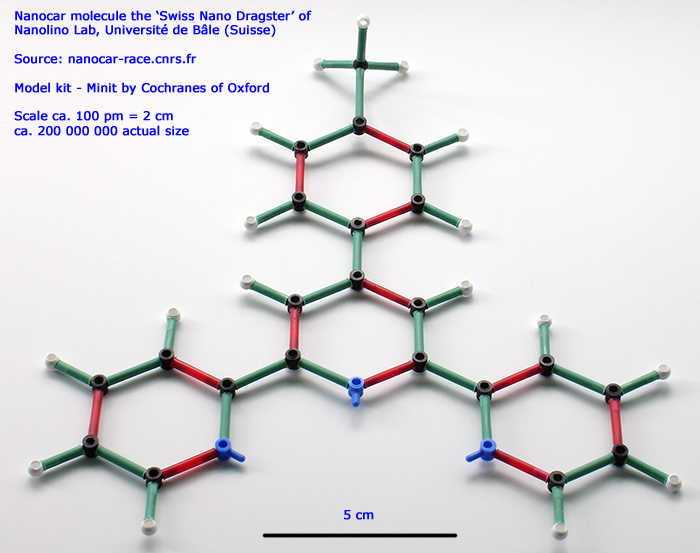
|
Micscape Lite - contributors sharing general articles on topics other than microscopy. by David Walker, UK |
The optical microscopy enthusiast will be very familiar with the precise manipulation of microscopic objects. The shells of tiny microorganisms such as diatoms and radiolaria as well as insect scales have for over a century been arranged into prepared mounts both for scientific and artistic purposes. Past masters include J D Möller whose arranged slides of diatoms, some presented in a microphotographic grid with species names in minute letters, now attract high prices. The ultimate preparation was his "Universum Diatomacearum Möllerianum" with 4026 diatoms arranged on a slide in an area 6 x 6.7 mm, illustrated here on Micscape, carefully photographed by Jef Schoors in collaboration with the slide's custodian, the Botanical Garden Meise, Belgium. The micromanipulation skills are continued to this day with modern practitioners including Klaus Kemp, Steve Beats and Stefano Barone.
As an amateur optical microscopist I've been fascinated with developments in the micro-reproduction of images / text through to modern advances in micro-manipulation. One of the earliest short features written for Micscape in October 1996 was 'How Small Can You Write' which highlighted aspects of the developments timeline, from microphotography in the 19th century, through microfiche and to the then recent work by IBM who were manipulating atoms with a scanning tunnelling microscope (STM) to create their logo and patterns on a surface at the atomic scale.
With the rapid advances in both the manipulation of atoms / molecules and their imaging, microscopic manipulation and live imaging has been further developed. In the past few decades there have also been great advances in the synthesis of molecules that can be described as molecular machines, some of which in the future may have important roles to play. The Nobel Prize for Chemistry in 2016 was awarded to three chemists Bernard Feringa, Jean-Pierre Sauvage and J Fraser Stoddart "for the design and synthesis of molecular machines".
An event was organised by CEMES-CNRS and recently completed in Spring 2017—a race of single molecule nanocars. The race was shown live online and attracted great interest in the media. It had a number of stated aims; in part to highlight the cutting edge developments in microscopy, exploring manipulation / imaging at the molecular scale under the harsh environment of an STM and showcasing modern developments in nanomachine synthesis. A summary of key details are provided below and Resources provides links to the host for detailed information.
The Race (for full details see Resources.)
Competitors: Six nanocar teams from around the world each with their chosen design of molecule to act as a nanocar.
Venue: Toulouse, France at CEMES-CNRS. Four teams each used one of the four probes in the 'low temperature scanning tunnelling microscope (LT-UHV-STM)'. It was designed by Scienta-Omicron for the race but had an important longer term role with its four probes allowing multiple users of an STM. Two teams controlled STM's at their home bases remotely from Toulouse with tracks and conditions identical to the Toulouse set-up.
Circuit substrate: Ultra clean Au(111) surface. Each team had their own track. One team's molecule was so fast it was run on a slower silver surface to handicap it.
Circuit geometry: A pre-defined 'runway' the same for each team with gold atoms as obstacles. Cited as "20 nm+1 turn + 50 nm+1 turn + 20 nm".
Track temperature: 5 K, - 268 °C
Pressure: Ultra high vacuum (UHV) 10-10 mBar in the scanning tunnelling microscopes.
Race length: Maximum of 38 hours.
Propulsion / 'Fuel': Competitors were not allowed to push the cars with the probe tips but must rely on other methods listed in the rules e.g. electron tunnelling using the probes or light.
For fun and with a long term interest in the use of physical molecular model kits to complement where possible software, I had a stab at building the six molecules from the information provided. It's interesting to note that although the teams shared attractive software rendered models online, the space-filling physical models were, dare I say, rather disappointing renditions from 3D printing. Perhaps an opportunity missed to encourage students worldwide to try building the models from the many molecular model kits available.
The nanocars built from either Minit or Orbit molecular model kits by Cochranes of Oxford. In order of rankings in the race.
In last month's Micscape (see Resources) I shared a comparative review of typical model kits from each of five current major brands; Minit, Orbit, Molymod (all from the UK) plus ChemKits and Molecular Visions (both from the USA). The Minit and Orbit kits are used below which can be regarded as ball and stick type kits, the Minit moving more towards the skeletal type of model kit. Although these type of kits don't show the true molecular shape which a space-filling model does, the former are arguably better at showing the intramolecular structure and atomic relationships.

Above: The "Swiss Nano Dragster" is one of the simpler molecules entered; a terpyridine group forming a major part and shown as the three aromatic rings with blue nitrogen atoms in each. Green and red bond links showing the single and double bonds of a Kekulé structure.
Placing in the race: Equal first place as the molecule to finish on the Au(111) surface. 133 nm were traversed in 6.5 hours.
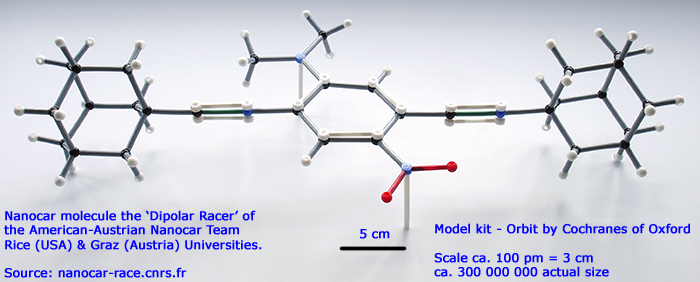
Above: The "Dipolar Racer" of the joint American-Austrian team. This team were rather coy about the exact molecule to be used in the race. An article on the Rice University website after the race "Rice University Tops All in Nanocar Race" did show the
race molecule and used for the model above. (The 3D rendered software model
and also used in promotional animations is an alternative four axled molecule.)
This is a two axle nanocar with triple bonds on each axle attached to adamantane groups, made of four connected cyclohexane groups (see Wikipedia adamantane entry).
Placing in the race: Equal first place. Pre-race trials found that it was so fast on the official Au(111) track that it was allowed to race on a slower silver surface. They were also further handicapped by being assigned a longer 150 nm circuit which they still completed the fastest in ca. 1.5 hours with an average speed of 95.2 nm/h.
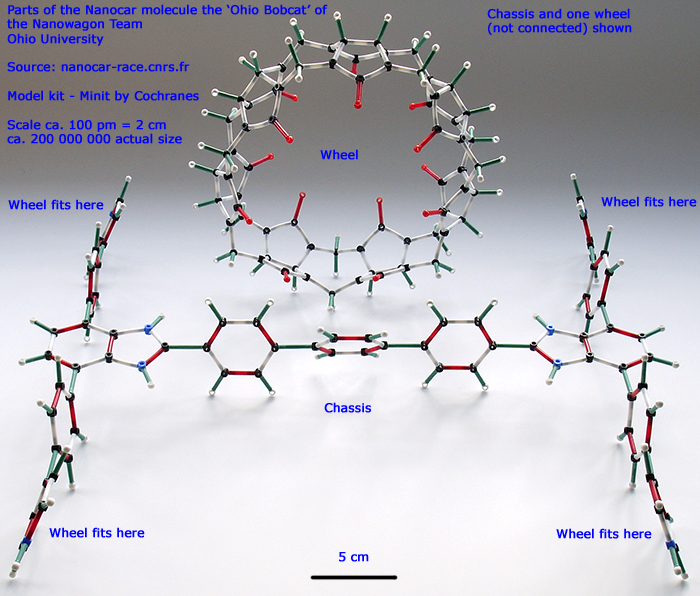
Above: The complexity of the 'Ohio Bobcat' nanocar was such that I don't own sufficient atoms in the Minit kit used to build the complete molecule. It is one of the two molecules entered that more closely resembles a four wheeled vehicle yet on the molecular scale. One wheel is shown independently and the fixing points of the four wheels on the chassis. The elegant wheels are cucurbit[7]uril molecules made from in this case 7 glycoluril monomers (see Wikipedia cucurbituril entry).
The sp˛ N atoms are not distinguished in the wheel due to limited N parts in the Minit kit. The red oxygen atoms face inwards in the ring.
Placing in the race: Overall second place, travelling 43 nm during the race. Awarded "The Texan Prize" reflecting it being the largest molecule in the race.
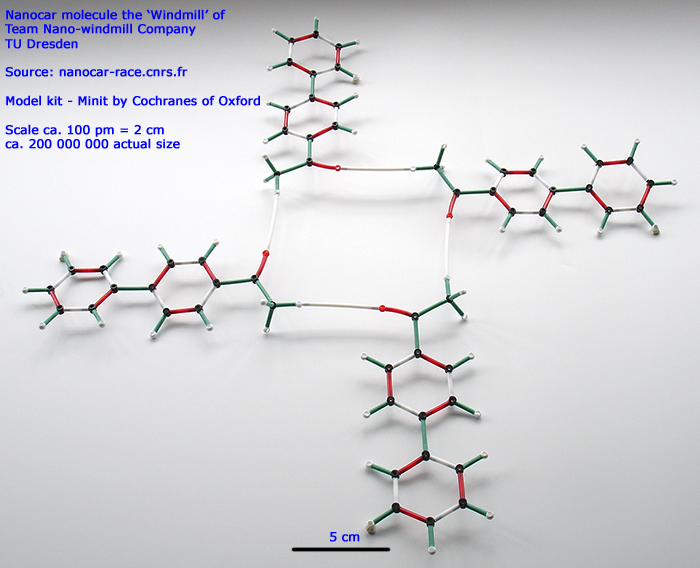
Above: The "Windmill" nanocar of the research group from TU Dresden used four acetylbiphenyl molecules that form on the race surface the four molecule structure. The long white bond links serve to represent the weak hydrogen bonding between the acetyl groups on each of four molecules. They are at the correct length at the scale used for the length of H-bonds which the team report
in their paper. The researchers note that each of the
outer four benzene rings can act as 'steering groups'.
Placing in the race: Overall third place achieving 11 nm in the race. Awarded "the perseverance prize" due to "difficulties encountered".
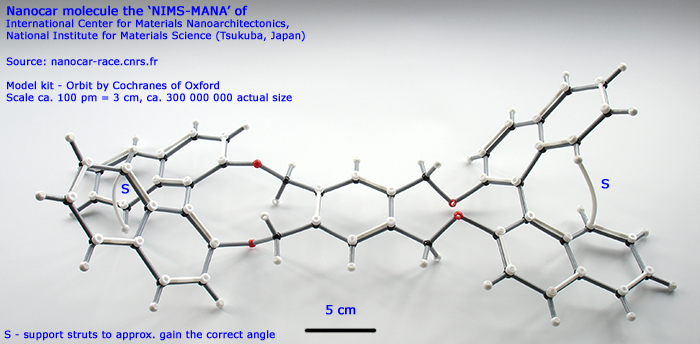
Above: The NIMS-MANA nanocar from the Japanese team. Described by the team as a binaphthyl dimer and who note that it has a "caterpillar motion" i.e. the molecule flexes.
Placing in the race: "Not ranked" but awarded the "The Fair Play Prize".
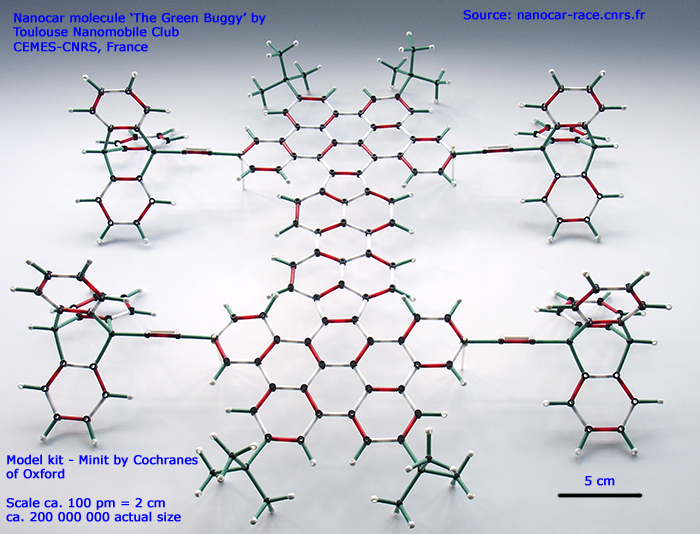
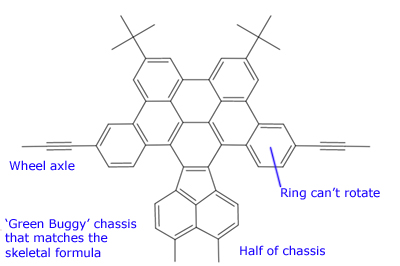
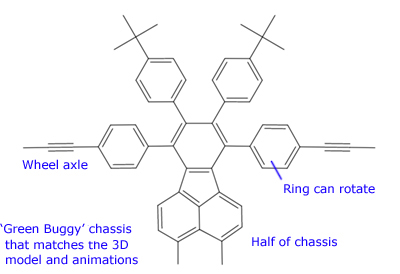
Above: 'The Green Buggy' by the Toulouse Nanomobile Club at CEMES-CNRS was the second of the two molecules entered that more closely resembles a four wheeled vehicle on the molecular scale. The chassis is primarily an extended aromatic ring system (the white and red links in the model representing one of the Kekulé structures). Two isopropyl groups terminate each end with a triple
bond in each of the four the linear axles. Each wheel is a triptycene group
i.e. three benzene rings arranged around two tetrahedral carbons.
The Minit model shown above is for a molecule with the structural formula illustrated in the synthetic pathway and the molecular formula C184H116 given in the team's background info'. Half the chassis for this molecule is shown above left. The 3D rendered molecule that heads their team page does not match it but another 'generation' referred to in their text and likely used for the race as
it's shown in the animations (see 'Chemistry World' feature in Resources). Both generations are shown on a blackboard at 10 seconds into the 'NanoCarRace: the Highlights' YouTube video. The half chassis for the 3D molecule is shown above right where the benzene rings on the axles can adopt near right angles to the chassis plane shown in the 3D model; this is not possible for the benzenes on the axles for the molecule shown above left.
Placing in the race: "Not ranked" but was awarded "the most beautiful car" for the quality of the images under the STM.
Comments to the author David Walker are welcomed.
Updated May 16th 2017.
Acknowledgements:
Thank you to the CEMES-CNRS website below and each team for providing the information to build the models above and to Rice University for the news page linked to above.
The structural formulae for the 'Green Buggy' used Herman Bergwerf's excellent open source MolView software.
Resources:
The CEMES-CNRS website and the post race web page has a wealth of information on the race, its background, the team information and their molecules as well as videos.
"First International NanoCar Race showcases molecular vehicles" - a feature on the Foresight Institute 'advancing beneficial nanotechnology' website which expands on some of the event's aims.
"World's first nanocar race crowns champion. C&EN follows the action on and off the track" by Matt Davenport - Chemical and Engineering News magazine and website feature dated May 2 2017. An extensive article featuring behind the scenes insights both before and after the race. Highlights the Ohio University team's entry.
"Nanocars gear up for first race of its kind after warm-up lap" - by Fernando Gomollón-Bel bated 14 November 2016. Feature on the Royal Society of Chemistry's Chemistry World website with embedded video. Mentions the two generations of nanocar molecule developed by the Toulouse team and the 'Green Buggy' used in the race.
"The Big Science of Small" by Jason Hagerman - feature on the Lab Business website discussing the wider field of nanotechnology with examples of conceptual molecular machines.
Micscape article:
A comparative review of five brands of molecular model kits. With notes on the educational merits of kits in an age of software. Compares five current major brands (ChemKits, Minit, Molecular Visions (Darling Models), Molymod, Orbit) with 'Molecules in the News' in Spring 2017 supplement
(heptacene, the 'elusive' triangulene and a molecular machine - a ratchet). PDFs
Published in the May 2017 edition of Micscape.
Please report any Web problems or offer general comments to the Micscape Editor .
Micscape is the on-line monthly magazine of the Microscopy UK web site at Microscopy-UK
©
Onview.net Ltd, Microscopy-UK, and all contributors 1995
onwards. All rights reserved.
Main site is at
www.microscopy-uk.org.uk.